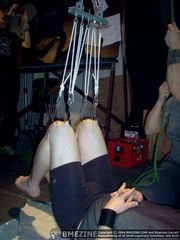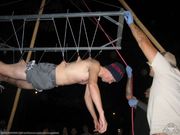Suspension Rig
The term suspension rig usually refers to the frame that sits between the flesh hooks and the rope system in a suspension. It may also refer to the suspension tower and complete suspension apparatus depending on how it is being used.
Contents |
Ropes and Webbing
There are many different types of rope, webbing, chain and cable that can be used for suspension. In general, most suspension groups work with the same materials that are used by climbers and professional riggers. The most common of these are nylon webbing (for attaching to support structures), rappelling rope (for connecting support structures to suspension frames) and parachute line (to connect the body to the suspension frame).
There are multiple knots that work well for suspension rigging. The two most common knots are figure eights and clove hitches. The figure eight knot is probably the most common knot, and is used both for primary and suspension rigging. It is an extremely strong knot and tightens down upon itself. It is very easy to untie. The clove hitch is an easily adjustable knot that is often used where the length of the ropes must be adjusted, such as suspensions that require multiple balanced rigging systems.
Rope should not be put through the piercings. Flexible materials are not a suitable substitute for hooks or other rigid structures. Materials such as rope will tighten around the piercing, causing the skin to be pulled to one point and rip. More rigid items, such as hooks, are definitely better choices unless the goal is to tear free (for example in a ball dance or Sundance type ceremony).
In addition, doing this would result in major contamination of the rigging system, on top of the fact that there isn't really any way to sterilize rope- stick to hooks.
Pulleys and Hoists
The two most common lifting mechanisms are "block and tackle" and "chain hoists." Block and tackle pulley systems have the advantage of being lightweight and are quick for lifting and lowering. The only drawback is that they require a physical point to secure the rope's end. These days, chain hoists are becoming more and more popular due to their self locking system that handles enormous amounts of weight.
Bars
Horizontal suspensions are normally done from a rectangular cube with multiple eye-bolts facing downwards on the long sides of the frame and four eye-bolts facing up in the corners. A single long bar design can be used as well for horizontal suspensions. Vertical suspensions are normally one from a single beam with five eye-bolts facing down and two eye-bolts facing up.
Setting up the Rig
The easiest way to set up a rig is to first connect one rope to a solid structure (such as a ceiling beam or a tree branch). To that, connect the suspension frame/rig at height where the suspendee will be off the ground, but is low enough that they can step off a chair or a table beneath them can be lowered. When the suspension is over, they step back onto the chair.
In an indoor environment, you can connect your rigging to one or more solid points of the building's superstructure, for example by placing a sling around an I-beam or by setting permanent points in wood or concrete buildings. As always, it is best to rig for at least three times the amount of weight you are expecting to hold.
If you want to rig a suspension with a tree outside, slings can easily be wrapped around large branches. Once the slings are in place, a block and tackle or hoist can be easily attached.
When you are attempting to suspend outdoors with nothing to suspend from, you will need to erect some form of stable structure. One of the fastest and most stable boxes can be built from scaffolding that is easily rented in any major city. Although there have been a lot of people designing freestanding suspension frames, it really seems at this point that scaffolding is the cheapest, easiest, and safest way to do it.
Dynamic Rigging
Dynamic Rigging in terms of suspensions refers to rigging several different anchor points with the use of only one rope. Dynamic rigging offers an advantage in suspension in that it minimizes the amount of knots needed and allows weight distribution to be adjusted throughout the suspension to either equally distribute weight or focus/remove weight from certain flesh hooks. Due to the nature of dynamic rigging it also removes the need to spend time tying multiple lines at exact lengths. One rare disadvantage to dynamic rigging is the potential for catastrophic failure. Since all hooks are maintained on a single line, a failure in any one hook, or in the line itself will cause the entire system to rapidly fail. If the failure in the system is due to a line break then the suspendee may simply be dropped completely away from the rig as the one line is responsible for maintaining all of the hooks on said line. These methods of failure should be understood by anyone rigging for a suspension and proper steps taken to avoid and spot failures before they occur.
Dynamic and static rigging should not be confused with dynamic and static lines (rope).


